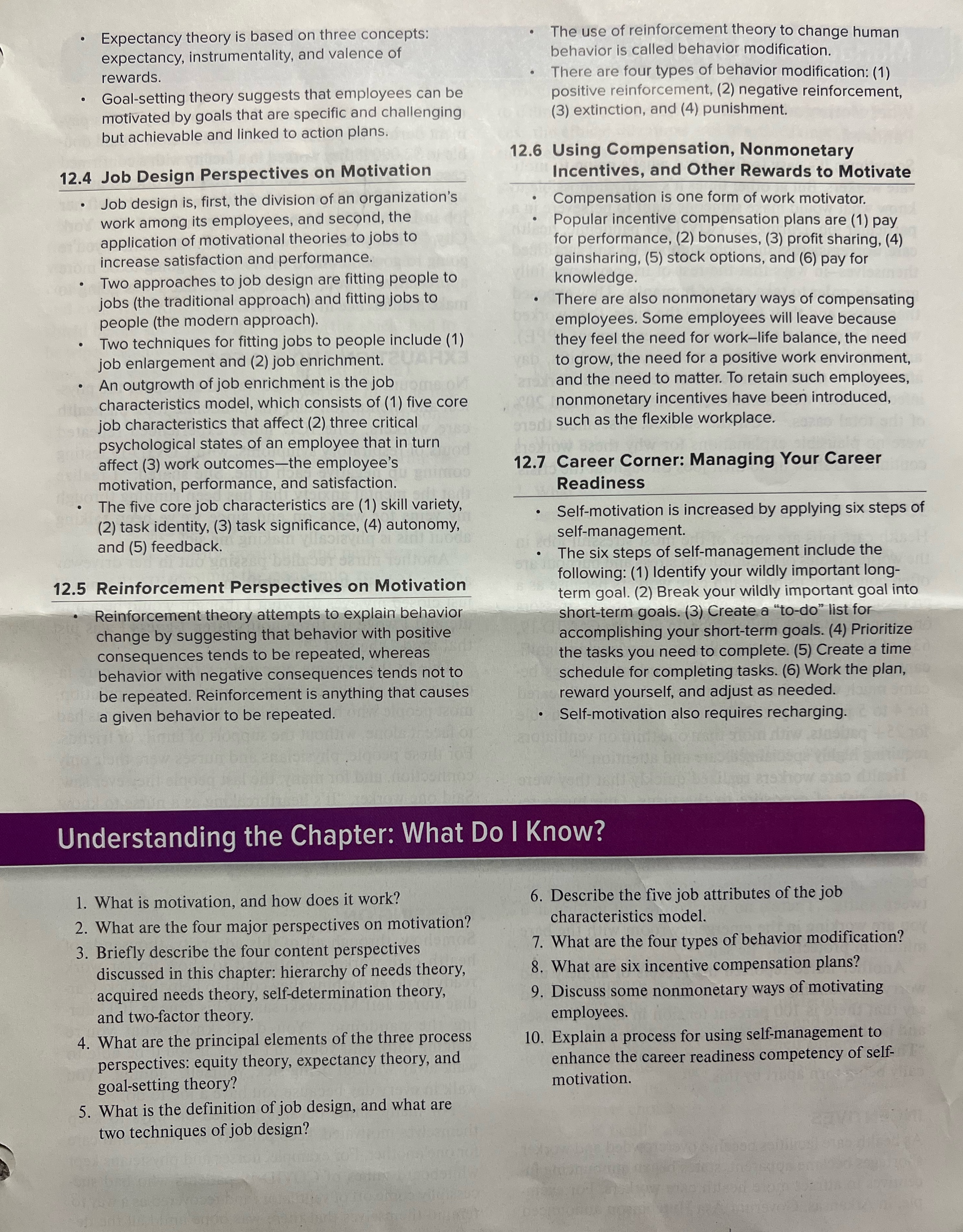1) what is the definition of job design, and what are two techniques of job design?2) Describe the five job attributes of the job characteristics model.3) What are the four types of behavior modification?4) Use all three components of Expectancy theory to explain why some employees make the effort to get to work in a very bad storm and others do not. (Hint: the task is getting to work, not on-the-job factors)
- Expectancy theory is based on three (oncopts: expectancy, instrumentality, and valence of rewards. - Goalsetting theory suggests that employees can be motivated by goals that are specific and challenging but achievable and linked to action plans. 12.4 Job Design Perspectivesron Motivation - Job design is, first, the division of an organization's work among its employees, and second, the application of motivational theories to jobs to increase satisfaction and performance. - Two approaches to job design are fitting people to jobs (the traditional approach) and fitting jobs to people (the modern approach). - Two techniques for fitting jobs to people include (1) job enlargement and (2) job enrichment. An outgrowth ofjob enrichment is the job characteristics model, which consists of (1) five core job characteristics that affect (2) three critical psychological states of an employee that in turn affect (3) work outcomesthe employee's motivation, performance, and satisfaction. The ve core job characteristics are (1) skill variety, (2) task identity, (3) task significance, (4) autonomy, and (5) feedback. 12.5 Reinforcement Perspectives on Motivation 12.6 12.7 The use of reinforcement theory to change human behavior is called behavior mOdification. "than are four types of behavior modication: (1) pOSliiViv minirw I'JlllQl'lt. (2) negative reinforcement, (3) extinction. and (4) punishment. Using Compensation, Nonmonetary Incentives, and Other Rewards to Motivate Compensation is one form of work motivator. Popular incentive compensation plans are (1) pay for performance, (2) bonuses, (3) profit sharing, (4) gainsharing, (5) stock options, and (6) pay for knowledge. There are also nonmonetary ways of compensating employees. Some employees will leave because they feel the need for worklife balance, the need to grow, the need for a positive work environment, and the need to matter. To retain such employees, nonmonetary incentives have been introduced, such as the flexible workplace. Career Corner: Managing Your Career Readiness Reinforcement theory attempts to explain behavior change by suggesting that behavior with positive consequences tends to be repeated, whereas behavior with negative consequences tends not to be repeated. Reinforcement is anything that causes a given behavior to be repeated. 1. What is motivation, and how does it work? 2. What are the four major perspectives on motivation? 3. Briefly describe the four content perspectives 7/ discussed in this chapter: hierarchy of needs theory, acquired needs theory, self-determination theory, and two-factor theory. What are the principal elements of the three process perspectives: equity theory, expectancy theory, and goal-setting theory? What is the definition of job design, and what are two techniques of job design? Understanding the Chapter: What Do | Know? 6. 10. Self-motivation is increased by applying six steps of self-management. The six steps of self-management include the following: (1) Identify your wildly important long- term goal. (2) Break your wildly important goal into short-term goals. (3) Create a \"to-do" list for accomplishing your short-term goals. (4) Prioritize the tasks you need to complete. (5) Create a time schedule for completing tasks. (6) Work the plan, reward yourself, and adjust as needed. Self-motivation also requires recharging. Describe the ve job attributes of the job characteristics model. What are the four types of behavior modication? . What are six incentive compensation plans? . Discuss some nonmonetary ways of motivating employees. Explain a process for using self-management to enhance the career readiness competency of self- motivation







